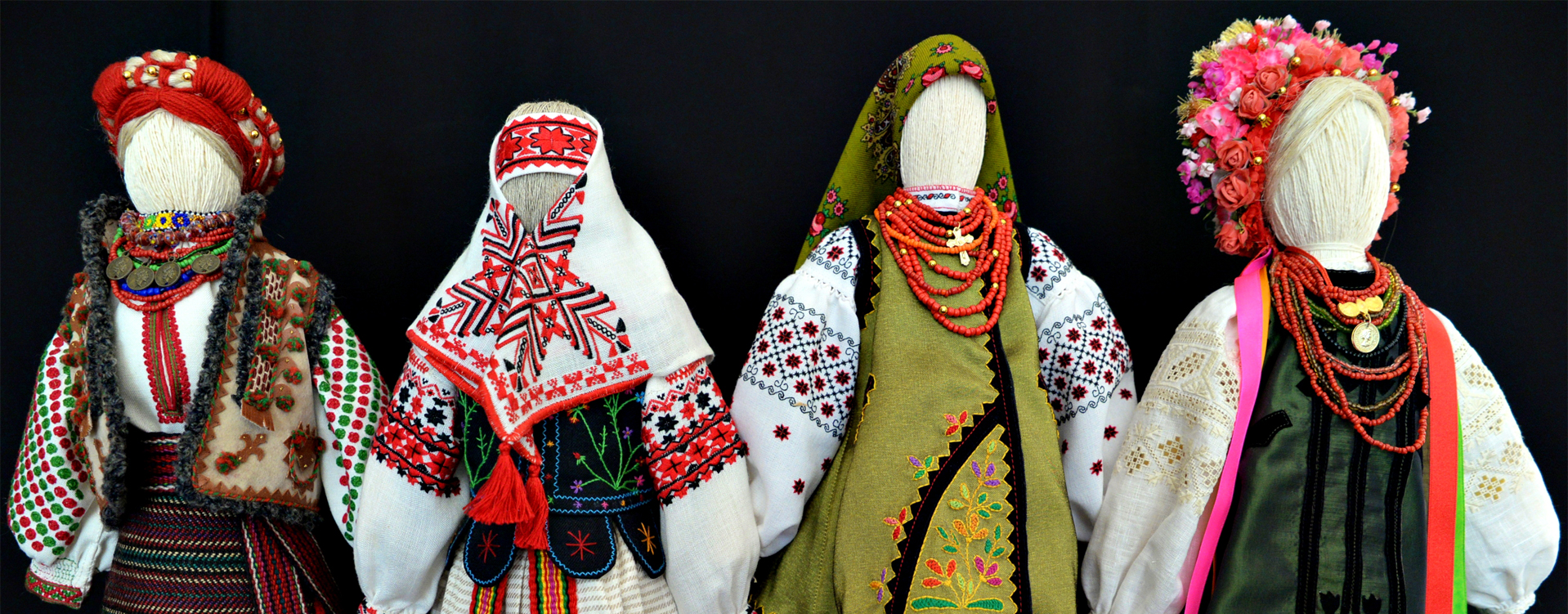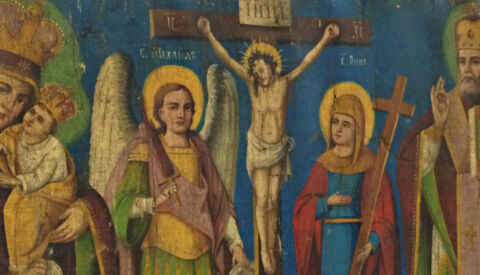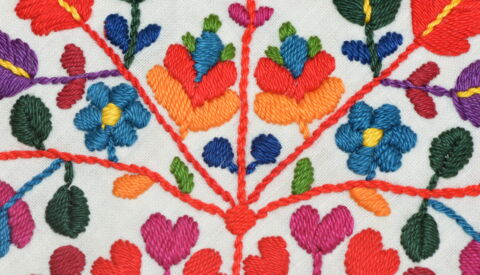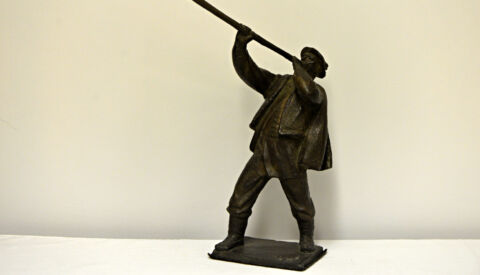Collection features folk arts and crafts of various regions of Ukraine including jewelry, decorative wood objects, pysanky (Ukrainian Easter eggs), straw weavings, ceramics, toys, and ceremonial breads
-
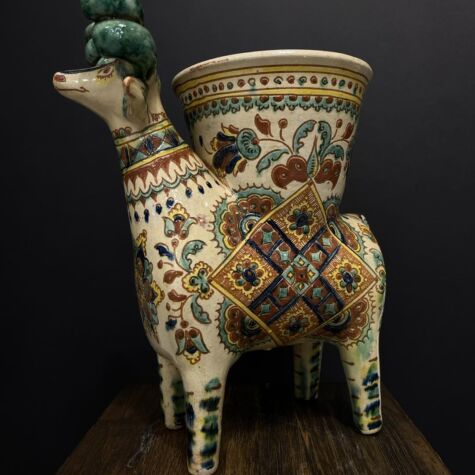
Kosiv Bowl
This beautiful ram bowl is an example of Kosiv painted ceramics. The bowl was made in 1968. Traditionally for Kosiv painted ceramics it is distinguished by its complex manufacturing technology and special decorations. Kosiv ceramics is included in the UNESCO Representative List of the Intangible Cultural Heritage of Humanity. Kosiv is a city in Ivano-Frankivsk region, center of the production. At the same time, the famous Kosiv center for artistic ceramics did not have the capacity to process the clay. It was supplied from Sloviansk. But after the start of the Russian’s full-scale war against Ukraine, it became extremely difficult and dangerous. Production was temporarily stopped.
-
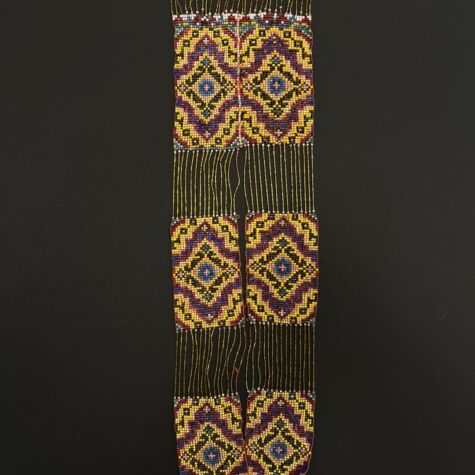
Bukovynian Rozetkovyi Gerdan
This 60 cm long rozetkovyi gerdan was made out of beads in Bukovyna cultural region, Chernivetska oblast. The top of the necklace that sits on the center of the back of one’s neck has 15 strands; both sides of beads are sewn onto and surround an orange cloth. Rozetkovi gerdany of 60 cm length (or more) started to appear in the 1930s, but shorter ones of approximately 30 cm length were first made in the late 19th century. The longest rozetkovi gerdany were found in northern Bukovyna and were worn by men. Men’s rozetkovi gerdany differ from women’s in width and length. Rozetkovi gerdany were also native to the Boiko, Hutsul, Pokuttia and Opillia regions of western Ukraine in the first half of the 20th century.
-
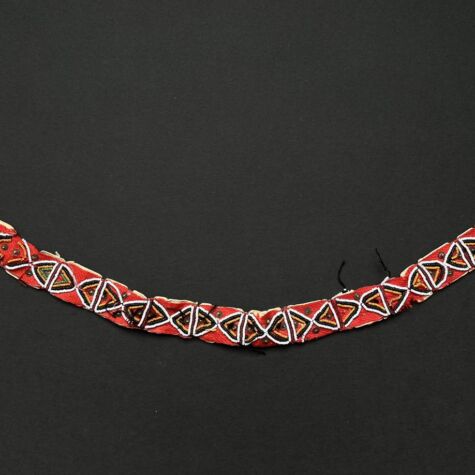
Bukovyna Sylianka
This vibrant sylianka was acquired by the museum in 1983 and measures 47cm in length. Sewn onto red twill tape and below a cardboard. The region of this piece is unknown.
-
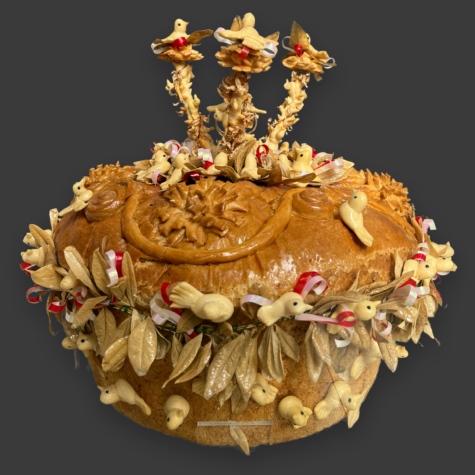
Korovai – Ukrainian ritual bread
-
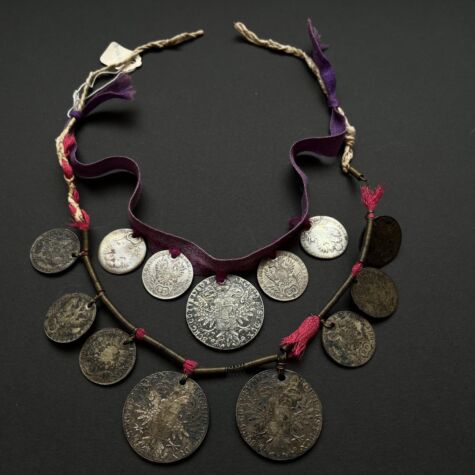
Zgardy
This beautiful zgardy made of two large Austro-Hungarian coins in the center and six smaller coins on the sides, has gold coils between them, and pink and brown yarn to tie. Dating back to c.1898, the history of this necklace is intriguing. The necklace was made in Ukraine in Shypyntsi village of Chernivetska oblast, Bukovyna. We also know that the original owner of this zgardy is Vaselka Lutsak. And Vaselka and Peter Lutsak were among the first settlers of Willingdon town.
-
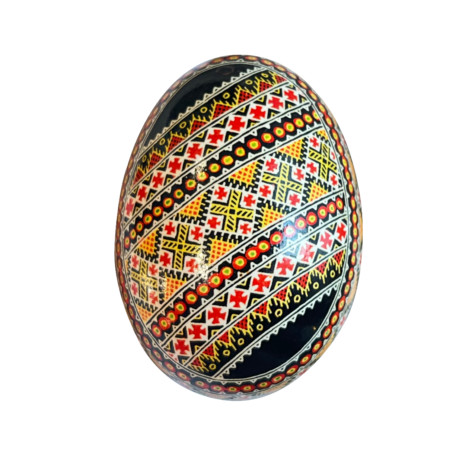
Easter Egg (pysanka)
from 988 A.D., when Ukraine accepted Christianity, the decorated Easter egg (Pysanka) became an important symbol in the Ukrainian rituals of the new religion. Pysanka stems from the verb pysaty (to write), as the designs are actually written on the egg, which is then dyed in several colors. Pysanky are raw and are not eaten. Every region, village, family had its own symbols, meanings and secret formulas for dyeing eggs.
-
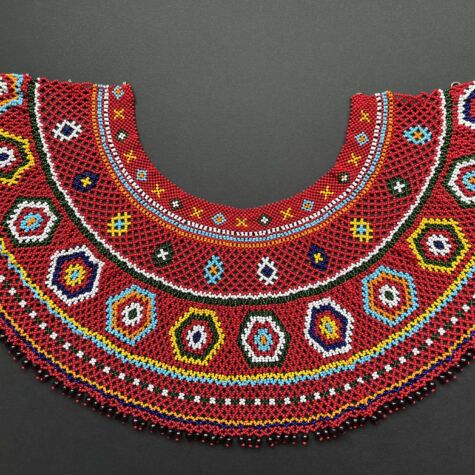
Kryza, Lemko region, Lviv, by Zveneslava Manko.
The “kryza” in Ukraine was called a wide beaded collar that completely covered a woman’s shoulders and chest and was traditional for Lemko region. Lemkos wore a lot of jewelry, the more of it, the richer a girl or woman was considered to be. Lemkos and Boikos wore them on holidays. Moreover, it took about 200 hours to make one such.
-
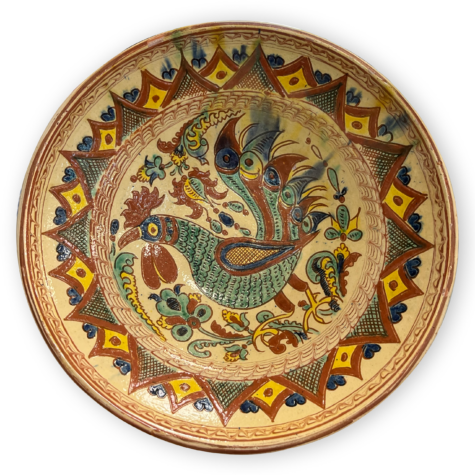
Traditional Hutsul Ceramic Bowl With Highly Elevated Rim. Kosiv, Hutsul region
From the late 1400s Kosiv, center of Hutsul region, emerged as a leading center for ceramic production. Early Hutsul ceramics painted with green, yellow, brown and less often blue (cobalt) glazes. Kosiv, Pistyn and Kuty were and remain the main centers of Hutsul ceramics due to their soil which is rich in clay.
-
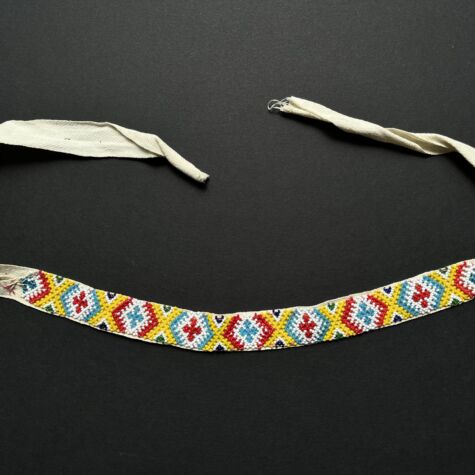
Sniatyn Gerdan 19th century
This shining beaded neck band called gerdan was made in 1896 in Tulova village, which is Sniatyn district of Ukraine. A ribbon gerdan is a ribbon-shaped jewelry that was popular in western Ukraine in the 19th century. First gerdans were made with very small Venetian beads. Gerdans were intended as amulets. Due to its bright colors, it was believed that it distracts people’s attention from the person who wears it.
-
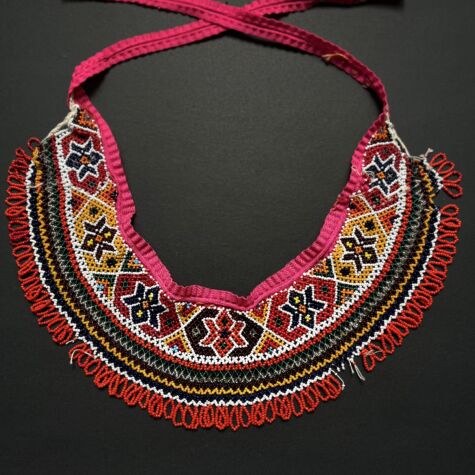
Sylianka 20th century, Ivano-Frankivsk region
This wide and colorful seed beaded necklace was made in the 20th century in Budyliv village, Ivano-Frankivsk region. Beaded collars were first made in Ukraine in the mid-19th century in the villages of the Hutsul region. Necklaces like this were called Syliankas, which had primarily an amulet function. The jewelry was supposed to protect its owner from negativity and also to be attractive in order to distract unwanted glances from the person.
-
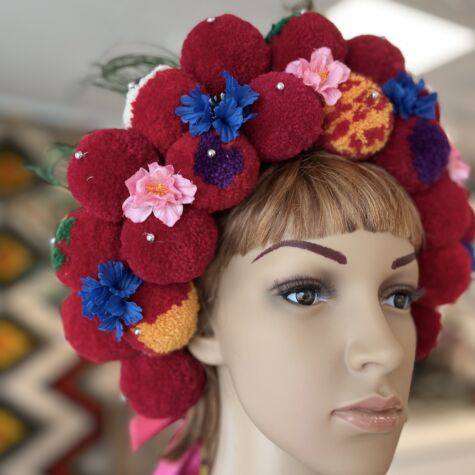
Poltava Wedding Wreath
The night of Ivan Kupala, unmarried girls used to make wreaths of wildflowers and herbs and let them float on the water. An unmarried girl wore a wreath of periwinkle, mint, sage, and other herbs. A wedding wreath was made of periwinkle, lovage, and other herbs, but since the 19th century, crested wedding wreaths have become a common type of bridal wreath in the Poltava region. They were made of pom poms on wires. Flowers, paraffin decorations, beads, and feathers were often inserted between the pom poms.
-
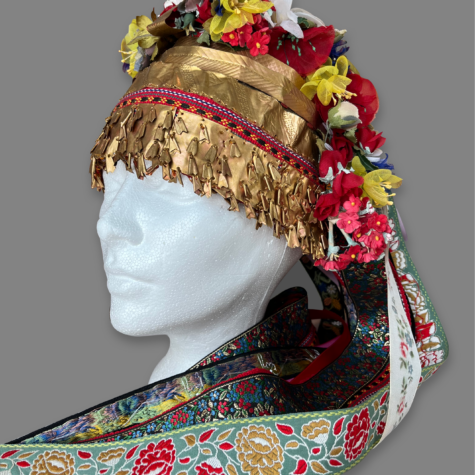
Chiltse – reproduction of a traditional Hutsul wedding headdress Yvanna Maraz Petrovvska, Ottawa, 1975
-
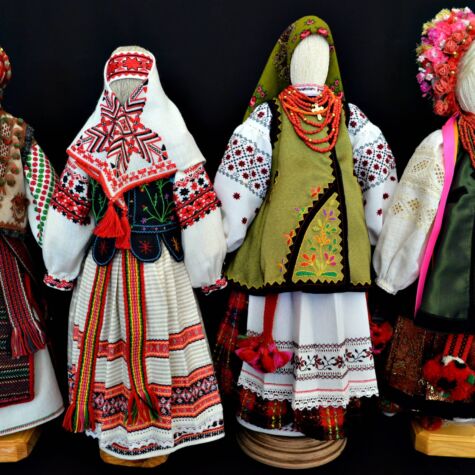
Motanky
The 4 motanky in late 19th and early 20th century authentic (though miniature) costumes were created by Yuriy Melnychuk from Kyiv. From left to right, they represent the following regions: 1) Hutsul region (Hutsulshchyna), Ivano-Frankivsk oblast 2) Western Polissia, Volyn oblast, or Volynske Polissia 3) Middle Dnieper River area (Serednia Naddniprianshchyna), Kyiv oblast 4) Middle Dnieper River area (Serednia Naddniprianshchyna), Poltava oblast
-
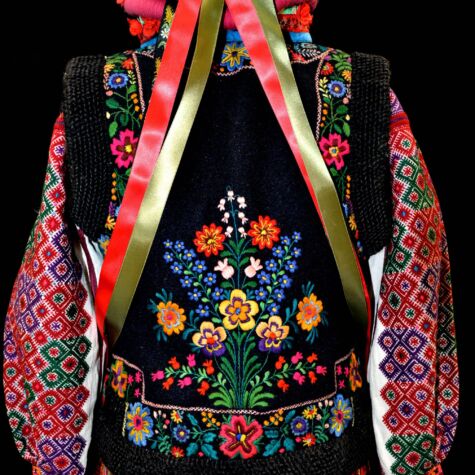
Horodenka bride outfit
This image shows the back of a wedding headdress made by Yvanna Maraz Petrovska of Ottawa. Petrovska fashioned the headdress based on tablytsia 16 of “Narodnyi odiah zakhidnykh oblastei URSR” (Kyiv, Vyd. Akademiia Nauk URSR, 1959) by famous Ukrainian artist Olena Kulchytska, who in the 1930s and 1940s went from village to village in Ukraine, sketching and painting the traditional Ukrainian folk dress she witnessed. Tablytsia 16 of Kulchytska’s monograph depicts a wedding headdress from Tyshkivtsi, Horodenka district, Pokuttia region from Kulchytska’s visit there in 1940. An additional wreath replete with periwinkle and four burgundy pompoms is placed on top of the shown headdress. UMCAB possesses the additional wreath but it is very fragile, as the little periwinkle leaves have dried out. The blouse, embroidered in nyzyna, is from Staryi Hvizdets, Horodenka district. The Horodenka district vest has a floral pattern that is embroidered in satin stitch and stem stitch, with a pink bordering line embroidered in kozlyk.
-
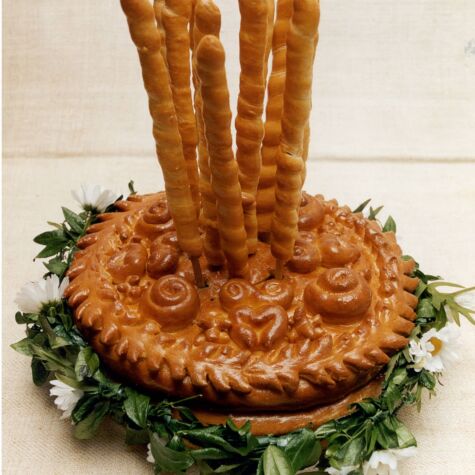
Wedding Bread
This korovai is from the Sokal region, which is in northern Lviv oblast (previously northern Halychyna province), in the Halytska-Volyn region. It was baked for UMCAB’s 1995 wedding exhibit which also doubled as the museum’s 50th anniversary exhibit. The lead curator-baker of the korovayi (plural) was Nadia Cyncar but she had an army of bakers working for her.
-
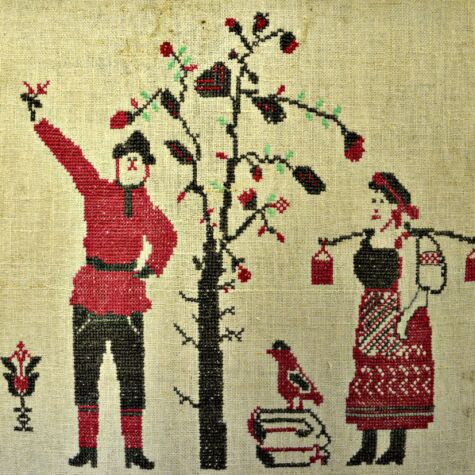
Rushnyk
This linen rushnyk shows charcoal, red and light aqua green (light Miami Dolphins green) cross stitch. The charcoal and red thread appear to be home-dyed. Underneath the part that is shown in the photo, there is embroidered “Оце тая криниченкька що голуб купався. Оце тая дівчинонька що Я улюблявся.” The verse comes from the Ukrainian folk song “Чи сеж тая криниченька” and its variants. These types of embroidered captions from that particular folk song often appear on central and eastern Ukrainian rushnyky that depict a young lady carrying well water and her boyfriend. This rushnyk was made in Poltavska hubernia.
-
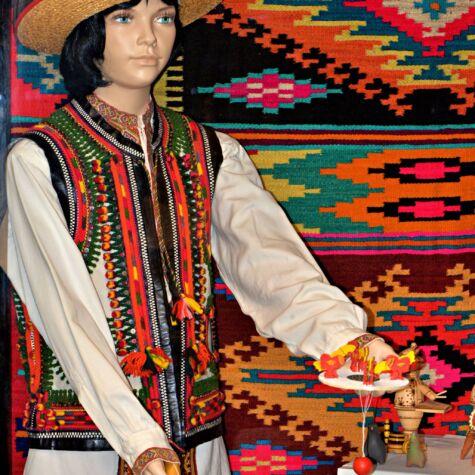
Boys vest and kylym
The teenage boy wears a faux animal skin kyptar from Hutsulshchyna. The hat was decorated in Alberta by Ukrainian community leader Peter Svarich of Vegreville, based on the type of hat young men from Sniatyn district, Pokuttia region (just north of the Hutsul region) wore when they were courting. In his right hand, the boy is holding a Pinocchio head with an attached hoop that is to be thrown up and onto the nose of Pinocchio. In his left hand he has a chicken feeding toy; whichever spot the ball swings to causes that particular rooster to duck his head for some feed. On the pedestal there is a wood carved tsymbalist decorated in pokerwork. The tapestry in the background is from Ruskyi Banyliv, which is just across the Cheremosh River in Bukovyna. Ruskyi Banyliv is in the subregion of Bukovynske Prykarpattia but some artifacts in this village, including the kylym in question, fall under the Bukovynska Hutsulshchyna subcategory, even though that subregion is a few kilometres to the south.
-
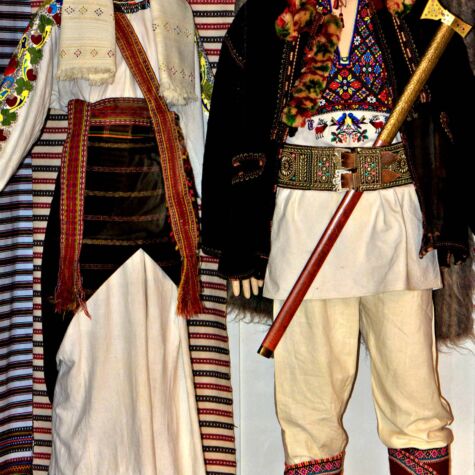
Man and Woman
The mannequin on the left is wearing a hempen chemise made in 1916 in Toporivtsi, central Chernivetska oblast, or Bukovyna. The chemise is embroidered with floral satin stitch and chainstitch, and is replete with silver sequins. In central Bukovyna, women sometimes hold their woven namitky in place with printed khustky wrapped around their heads as shown, sometimes even foregoing the additional wrap around the neck and just letting the two ends hang low on either side. Women from central Bukovyna also sometimes fold up and tuck both bottom corners under their belts (as shown); typically in Bukovyna only one bottom corner is brought up and tucked under the kraika. A skatert (narrow tablecloth) hangs in the background behind her. The male mannequin from Hutsulshchyna is wearing an embroidered wedding shirt, a wool coat called a serdak, and linen pants (though Hutsul men often wear red wool pants). His calves and ankles are wrapped with woolen burgundy kapchuri and leather postoly. A metal-bladed and partially metal-plated wooden-handled axe is tucked into his wide cheres (belt). Hutsul men will commonly wear or carry axes at social events like marriages and Christmas carolling.
-
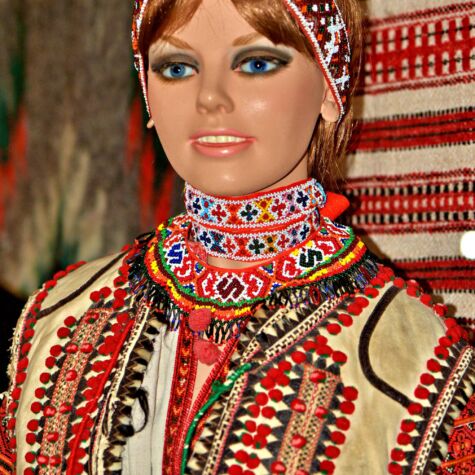
Woman in vest with necklace
The girl from Horodenka district, Pokuttia region, is not married, as she doesn’t have a head cloth on her head, but rather a beaded gerdan. There is another long gerdan (actually a beaded belt) wrapped twice around her neck and a curved beaded sylianka below this. Her sheepskin vest (kyptar) was made in 1875 in Torhovytsia, Horodenka district, Halychyna; it’s a style of vest that was common at that time in the adjacent Pokuttian districts of Horodenka and Sniatyn. Her hempen chemise was made in the early 20th century.
-
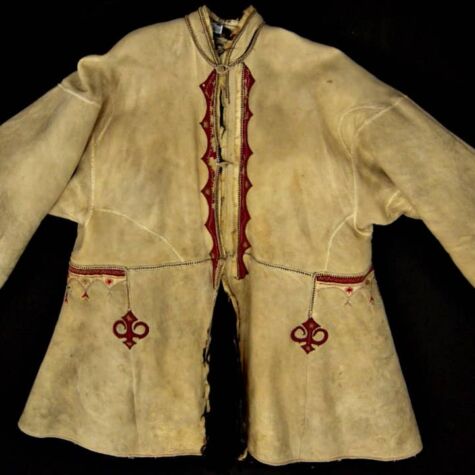
Sheepskin coat
This is a Bukovynian sheepskin coat (kozhukh) .
-
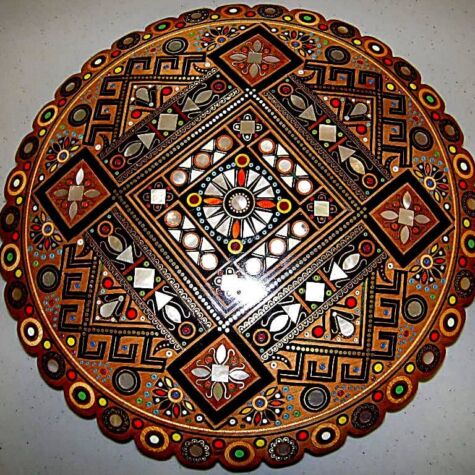
Hutzul container
The Hutsul container for cheese is called a rakhva. Its lid (shown) and the container’s sides (not shown) are carved and inlaid with mother of pearl, beads, narrow strips of copper and painted wood.
-

Floral wooden plate
The colorful floral plate is in Petrykivsky rozpys, which takes its name from the village Petrykivka, now in Dnipropetrovsk oblast, where this style has been most prevalent. This folk painting style dates back to at least the 18th century. It is believed to have originated either in Petrykivka or in the Sloboda region (near Kupiansk, Kharkiv oblast). Reports of floral mural painting from the 1860s exist from both these areas, and there was considerable migration from Sloboda region to the area of present day Dnipropetrovsk oblast from the mid 18th century through the mid-19th century. Painting similar to Petrykivsky rozpys has also been found on ancient Cossack articles. The Petrykivski artists use different paints for different surfaces. They typically use oil paint and lacquer for wooden surfaces. They traditionally paint directly onto the surface with a brush (traditionally made from cat fur) without any preliminary sketches. In 2012, Ukraine’s Ministry of Culture recognized the Petrykivka painting as a part of intangible cultural heritage of Ukraine, and it was included in the UNESCO Representative List of the Intangible Cultural Heritage of Humanity in 2013.
-
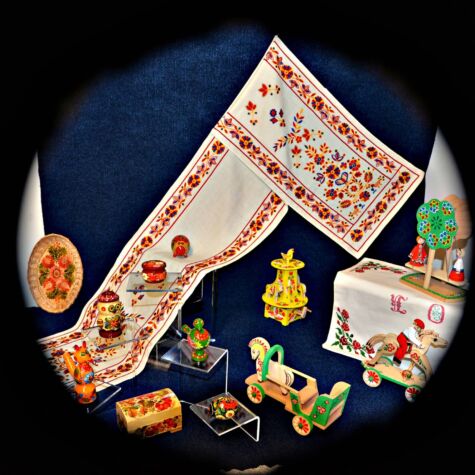
Toys and Rushnyk
The four larger toys on the right, including the yellow carousel, the couple on the tree swing, the Cossack on the horse and the horse and wagon were all made by Vasyl Luhansky of Novomoskovsk, Dnipropetrovsk oblast. The woven willow tray to the left is by Mykola Nizhyn of Chernihivska oblast. The smaller toys and miniatures (including the little chest) are anonymous Petrykivski rozpysy. The rushnyk that is hanging was embroidered in the style of the Dnipropetrovsk area by Antonia Kucher circa 1970.
-
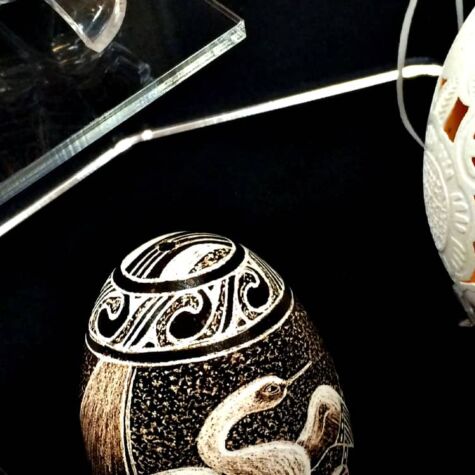
Easter Egg
The etched and carved goose egg is by Oksana Bilous of Kyiv. Her pysanky have been presented to ambassadors and former Ukrainian president Viktor Yushchenko has ordered pysanky from her several times. The black and white pysanka displaying a goose is done in scratch technique and is called a drapanka.


